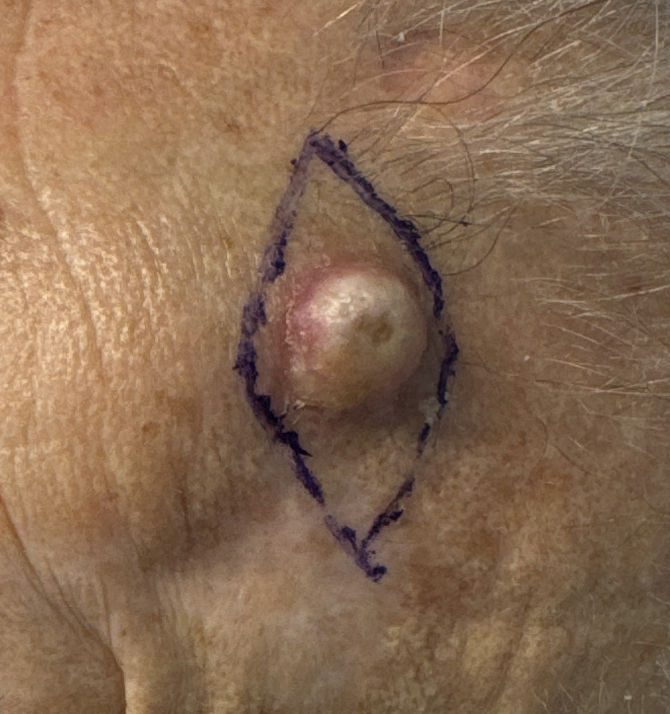Squamous Cell Skin Cancer (SCC) : What You Need to Know for Early Detection and Treatment
While basal cell carcinoma (BCC) is the most common skin cancer, squamous cell carcinoma (SCC) is the second most common—and often more dangerous. It has a higher potential to spread to other parts of the body if not caught early.
I'm Dr. Finbar, a GP with a special interest in dermatology, and in this blog, I’ll explain what SCC is, what it looks like, what causes it, and the treatment options available—including some promising new therapies.
What Is Squamous Cell Carcinoma?
SCC is a type of non-melanoma skin cancer that starts in the squamous cells of the epidermis—the outermost layer of the skin. While most SCCs are not life-threatening, they can become serious if left untreated, particularly if they grow large or spread to the lymph nodes or other organs.
SCC accounts for around 20% of all skin cancers and is more common in people over 60, especially those with fair skin and a history of sun exposure.
What Causes SCC?
SCC is primarily caused by cumulative, long-term sun exposure. Ultraviolet (UV) radiation from the sun or sunbeds damages the skin over time, which can lead to cellular changes that result in skin cancer.
SCC often arises from precursor lesions such as:
-
Actinic keratosis (solar keratosis): rough, scaly patches that may feel like sandpaper
-
Bowen’s disease: a superficial early form of SCC confined to the top layer of skin
However, SCC can also develop in previously normal skin, without any obvious warning signs.
What Does SCC Look Like?
SCC can vary in appearance, but typical signs include:
-
A scaly or crusty patch
-
A firm red lump that may grow quickly
-
An ulcer or sore that doesn't heal
-
Itching, bleeding, or pain (though it may be painless)
-
Rough, wart-like growths in sun-exposed areas
SCCs often appear on the head, neck, face, lips, ears, forearms, or backs of hands—all areas that get frequent sun exposure. They can develop over a matter of weeks, so it's important to keep an eye on any new or changing lesions.
![Image: Examples of SCC and dermoscopy] (Optional image reference for blog)
Why SCC Needs Prompt Attention
While basal cell carcinomas rarely spread, SCCs can spread—most commonly to lymph nodes, and in rare cases, to internal organs.
After removal, SCCs are assessed under the microscope by the pathology team. They grade the tumour based on:
-
Size (larger tumours carry more risk)
-
Clear margins (was all the cancer removed?)
-
Nerve involvement (perineural invasion)
-
Differentiation (how abnormal the cells appear)
Poorly differentiated SCCs are more likely to recur or spread.
That’s why early diagnosis and treatment is so important.
Treatment Options for SCC
Most SCCs can be effectively treated if caught early. Treatment depends on the size, depth, and location of the tumour, as well as your overall health.
✅ Surgical excision
This is the most common and effective treatment. The lesion is cut out under local anaesthetic and sent for histology to ensure clear margins.
✅ Radiotherapy
Used when surgery isn’t suitable—for example, in very elderly patients or those with larger, more difficult-to-remove tumours.
✅ Cemiplimab (immunotherapy)
A new and exciting option for advanced or inoperable SCC.
-
How it works: Boosts your immune system’s ability to detect and destroy cancer cells.
-
Originally used as an intravenous infusion, it's now being trialled as a direct tumour injection.
-
Still in specialist use, but may become more widely available as cost and safety concerns are addressed.
💬 Could this replace surgery in the future? Possibly—but we’ll need more research.
How to Protect Yourself
The best treatment is prevention and early detection. Here’s what I recommend to my patients:
-
Wear sunscreen daily (UV index 3 or above)
-
Avoid sunbeds
-
Cover up with protective clothing and hats
-
Check your skin regularly—especially areas that get frequent sun exposure
-
Get new or changing lesions checked early
Final Thoughts
Squamous cell carcinoma may not be as common as BCC, but it can be more aggressive, especially if diagnosis is delayed. Knowing what to look for—and acting quickly—can make all the difference.
If you’re concerned about a scaly patch, non-healing sore, or fast-growing red lump, don’t ignore it. It could be nothing—but it might be SCC. The sooner it's assessed, the better the outcome.

Share this post on:
Copyright © 2024 Dr Finbars' Skin Clinic All rights reserved.



